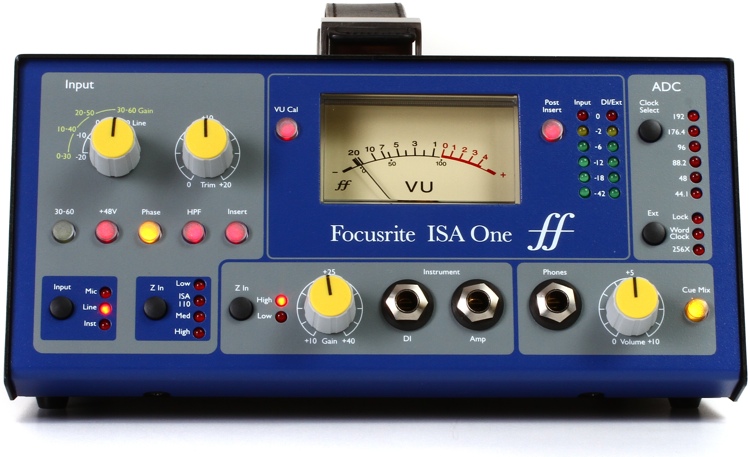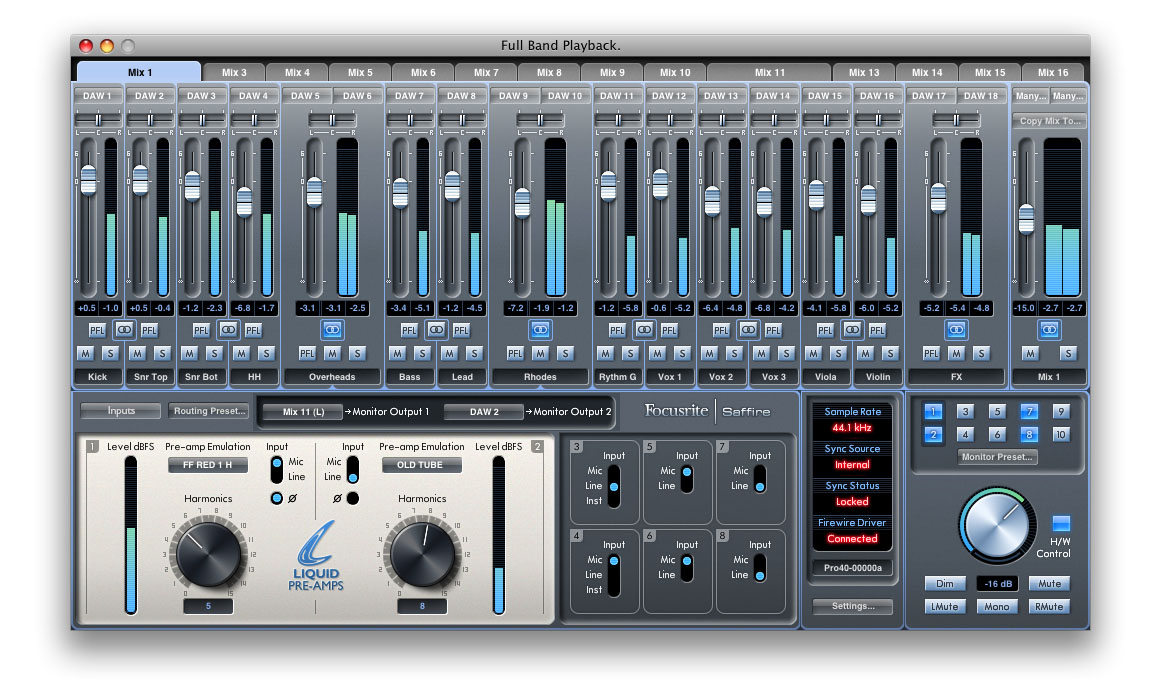Ok, so I just went out and purchased my first Preamp. I've always milked everything out of the pretty decent preamp built into my 18i20 Focusrite audio interface, but I realized it was time for something new. I bought the ISA one Focusrite pre and the preamp offers more subtle definition, much finer control over gain levels, different impedances including one of the most famous and well regarded Rupert Neve amps. This is all great, and I'm enjoying it all, but, I'm getting a noticeable (but subtle) and unpleasant distortion to certain takes that doesn't correlate to actual clipping.
The mic being used was the Lewitt Lct 540 and at normal gain levels with the preamp, I'm getting slight distortion in certain phrases. I know it's not true distortion because when I wail into the mic, it doesn't distort. It seems to be almost completely random. I understand that I may just be riding the gain too hard, but I still hear this even when I take the gain so low the needle doesn't move and I barely have a signal. I'm sure this user error because when I dial the gain back there's still this issue but it's much much less noticible. I tried different impedances and making sure the compression in my DAW wasn't affecting this. I just don't know what to do. Help please! Thank you!

Comments
I'm going to "page" one of our resident expert engineers here on
I'm going to "page" one of our resident expert engineers here on RO, who just so happens to have experience with the ISA line of preamps that you are using and currently having issues with...
( @pcrecord )
I could wager a few educated guesses as to what might possibly be occurring, but I'm gonna wait to see what Marco says first. ;)
d.
Thank you so much Donny!! It is really appreciated!!
Thank you so much Donny!! It is really appreciated!!
Your post implies you did not hear this trouble when you use the
Your post implies you did not hear this trouble when you use the same microphone directly into one of the 18i20 mic inputs. Is that correct?
Can you explain your signal routing in more detail? Are you taking the output of the ISAone into a line input on the 18i20? If so, what sort of cable (and connectors) are you using for this link?
You use phrases like "normal gain levels" that don't have much meaning in an engineering context. How much gain is this? Does it make any difference to the distortion when you use the low gain input range (Mode 1) rather than the high gain (Mode 2)?
This may take another performer in a different room to sing into the microphone, but can you hear the problem on headphones plugged into the ISAone? If you set the 18i20's internal routing matrix to output your microphone channel directly to headphones (i.e. not going through the DAW), can you hear the problem then?
Yup! Didn't have this issue when plugged directly into the 18i20
Yup! Didn't have this issue when plugged directly into the 18i20. I'm using a Mogami Gold XLR to 1/4 inch from the direct output on the Pre to the input on the interface. Sorry about the rental use of "normal gain" I'm not home right now so I don't know the specifics, but I meant when the gain is turned to a point where the levels are being picked up (needle is moving) but it doesn't come close to clipping or "going into the red". When monitoring a vocal directly from the ISA, I don't hear the distortion at all. It's super clean and distortion free. Only when monitoring from my DAW. Again thanks, Boswell!
First, make sure you switched your input to line and not mic (in
First, make sure you switched your input to line and not mic (in mixwizard)

The ISA nominal output is higher then consumer products many audio interface have this kind of adjustments to match the outboard gear :
I had to reajust these settings with my RME interface because the signal was too hot..
Also the ISA meter can be calibrated to better match what the interface is sensing. The text from focusrite :
Calibration:
Both the VU meter and the LED meters can be calibrated using the two corresponding dials on the rear panel (see the Rear Panel
section for the exact location). This allows a more suitable range for the meters, so that the signal being recorded can be displayed
in an appropriate way. A low level signal, for example, will not display much activity on the meters, which can be rectified by
reducing the dBu level represented by 0VU (VU meter) or 0dBFS (LED meters). The meters are calibrated in the following way:
DKAUDIO, post: 435285, member: 49673 wrote: Yup! Didn't have thi
That's good to know, and that cable should be fine. The ISA is capable of overloading a line input of the 18i20, but since you say you hear the problem at other than full output on the ISA, it's unlikely to be that.
Since you have tried headphones plugged into the ISA, it's worth trying them plugged into the 18i20 to see if the signal is "super clean and distortion free" there as well. It will mean setting the 18i20's internal routing matrix to get a direct headphone out, but this will also mean you could do a direct headphone comparison between the signal being sent into the DAW and the monitor output from the DAW.
Because I don't have any signal going from the interface to the
Because I don't have any signal going from the interface to the preamp, the signal I was hearing when plugged into the Pre was a completely dry signal, only from the pre. I do hear that distortion when I am monitoring from the 18i20, whether it's monitors or headphones.
pcrecord, post: 435288, member: 46460 wrote: First, make sure yo
This makes sense! Can you elaborate a bit more on matching the interface levels to the outboard gear? There isn't any such switch on my interface. Is this a DAW change?
DKAUDIO, post: 435291, member: 49673 wrote: Because I don't have
I think we are talking at slightly cross-purposes. You have shown that the headphone output of the ISA is clean (distortion-free). We now have to chase that signal further on down the chain towards the DAW, and the next possible monitoring point is the internal matrix of the 18i20 before it goes into the computer. What comes out of the headphone socket is of course not the analogue input signal directly, as it will have gone through an A-D-A conversion process in the 18i20, but at least it is a version of the signal that has not gone into the DAW and back out again.
Ahhhh that makes sense! Alright. When I'm home this afternoon I
Ahhhh that makes sense! Alright. When I'm home this afternoon I will give that a shot and then get back to you. Thank you!!
Boswell, post: 435295, member: 29034 wrote: What comes out of th
I don't think Bos... There is a phone output on the ISA one, I think that's the one he's talking about.

If so, it sounds to me like a level mismatch between units. Is i
If so, it sounds to me like a level mismatch between units. Is it ??
Boswell, post: 435295, member: 29034 wrote: I think we are talki
Here is a little segment of what Im talking about. This was recorded with very low levels on the preamp, and at points you can hear slight distorting at certain phrases.
[MEDIA=audio]http://recording.or…
Are you using an XLR cable from the output on your ISA One to an
Are you using an XLR cable from the output on your ISA One to an input on the 18i20? If so then you are preamping a preamp. To automatically disconnect the preamp section in the 18i20 you have to use a TRS cable on its input. The switching is internal and automatic. It makes it a LINE IN rather than a MIC PREAMP IN. Then you will only be using the MIC PREAMP in the ISA and the 18i20 input will function as a line level input to its mixer or the software in your audio program whichever you are using.
Thank you for the advice! I do happen to be using an XLR to 1/4t
Thank you for the advice! I do happen to be using an XLR to 1/4th inch cable to the input on the back, so I think that Im already cancelling out the second mic pre on the interface. Unless there's a difference between TRS and standard tri-tipped quarter inch cable.
Thank you!
As I said earlier, make sure you set the preamp input to line in
As I said earlier, make sure you set the preamp input to line in the mix control software :

DKAUDIO, post: 435472, member: 49673 wrote: Thank you for the ad
Nope. No difference in this case. That should be correct. So the problem is elsewhere